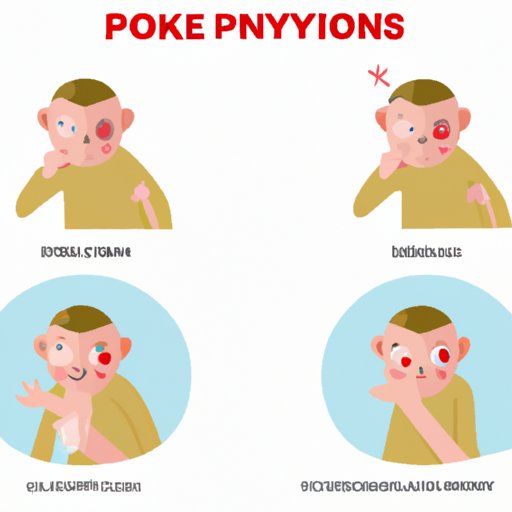
Introduction
Monkey pox is a rare viral disease that occurs mostly in remote areas of Central and West Africa. The disease is caused by the monkey pox virus, a member of the Orthopoxvirus family, which also includes the viruses that cause smallpox and cowpox. Understanding the symptoms of monkey pox is essential for early detection, proper treatment, and prevention of its spread.
A Comprehensive Guide to Monkey Pox Symptoms: Everything You Need to Know
Monkey pox symptoms can range from mild to severe and can last for a few weeks. The first symptoms of monkey pox usually appear within 5 to 21 days after exposure to an infected animal or person.
Monkey pox is primarily spread to humans through contact with infected animals, such as rodents or monkeys, or through close contact with an infected person. It can also be transmitted through contaminated materials or surfaces, such as bedding or clothing.
The first documented case of monkey pox was reported in 1958 when outbreaks of a pox-like disease occurred simultaneously in monkeys kept for research and in humans who came into contact with the infected animals. Since then, there have been sporadic outbreaks of human monkey pox in Central and West African countries.
Recognizing Monkey Pox Symptoms: How to Identify and Treat the Virus
Initially, monkey pox symptoms can resemble those of the flu, including fever, headache, muscle aches, and fatigue. However, as the disease progresses, distinctive rashes and papules appear on the skin, which eventually becomes pustular and forms scabs before healing.
Other symptoms may include swollen lymph nodes, sore throat, cough, and shortness of breath. In severe cases, patients may experience complications like meningitis, encephalitis, or sepsis. Treatment for monkey pox involves supportive care, such as pain relief and hydration. Antiviral medications, such as cidofovir, are available but have not been proven to be effective.
It is crucial to seek medical attention immediately if you develop any symptoms of monkey pox. Early diagnosis and treatment can help prevent serious complications and reduce the spread of the virus.
Monkey Pox: Symptoms, Treatments, and Prevention Strategies
Preventing monkey pox involves avoiding contact with infected animals, practicing good hygiene, and getting vaccinated. Vaccination can reduce the risk of monkey pox infection and is recommended for people who are at high risk of exposure, such as those who work with animals or people who live in areas with outbreaks.
To prevent the spread of monkey pox, affected individuals should be isolated and treated in a hospital or other healthcare facility. Close contacts should also be monitored for symptoms and receive preventive treatment or vaccination if necessary.
From Rashes to Fever: Unpacking the Symptoms of Monkey Pox
The symptoms of monkey pox can vary in severity and can be difficult to distinguish from other viral illnesses like chickenpox, measles or smallpox. However, unlike smallpox, monkey pox is not highly contagious and does not have a high mortality rate. It is important to consult a healthcare provider to confirm the diagnosis and begin appropriate treatment as soon as possible.
The following is a list of common monkey pox symptoms:
- Fever
- Headache
- Muscle aches
- Backache
- Swollen lymph nodes
- Chills
- Fatigue
- Sore throat
- Cough
- Shortness of breath
- Rash
The rash associated with monkey pox can vary significantly from person to person and can take several forms, such as scattered macules, papules, vesicles, pustules, and scabs. The rash often starts on the face and trunk and spreads to the arms and legs. It can last for several weeks and can be accompanied by itching, swelling, and other discomfort.
The Early Warning Signs of Monkey Pox and When to Seek Medical Attention
The early signs of monkey pox include fever, headache, muscle aches, and fatigue. These symptoms may be accompanied by a rash, swelling of the lymph nodes, or other symptoms. If you have traveled to or lived in an area with monkey pox outbreaks or have come into contact with infected animals or people, it is important to monitor yourself closely for any symptoms of the disease.
If you suspect you have monkey pox, seek medical attention immediately. A healthcare provider can evaluate your symptoms, perform diagnostic tests, and prescribe appropriate treatment.
A Closer Look at Monkey Pox Symptoms: Understanding the Virus and Its Effects
Monkey pox can cause long-term effects, especially in severe cases, including scarring, blindness, limb deformities, and neurological damage. However, most people recover from monkey pox without experiencing any long-term effects. The severity of monkey pox symptoms can vary from person to person and is influenced by factors such as age, health status, and the strain of the virus.
Key takeaways from this article include the importance of early detection and treatment of monkey pox, preventive measures like vaccination, and proper isolation and treatment of affected individuals to prevent the spread of the virus.
Conclusion
Monkey pox is a rare viral disease that can cause a range of symptoms from mild to severe. It is essential to understand the symptoms of monkey pox, to seek medical attention immediately if you suspect you have the virus, and to take preventive measures like vaccination. Knowing how to recognize and treat monkey pox symptoms can help prevent the spread of the disease and minimize its impact on your health.





